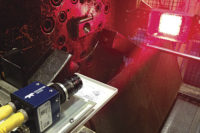Brainstorming Today and Tomorrow
Don't allow your tools to inhibit creative thinking.

You are leading an improvement team. Leadership wants fast results. So, you and your team need new ideas fast. The team sits around a table and you ask your team members to shout out ideas. There’s no discussion, no bad ideas, no thought given to the feasibility of implementing those ideas—just get those ideas down on paper. You take the ideas back to your desk and figure it out, sometimes with, sometimes without, excitement.
This is probably, if not a common occurrence, one that you readily identify with. At some point in your career you undoubtedly have led and/or participated in brainstorming sessions. The method described above is a common form of brainstorming. According to Carol Knight-Wallace, this form of brainstorming has a term: popcorn brainstorming.
The purpose of brainstorming is to get your team thinking creatively. Simply asking your team members to throw ideas out without getting to the meat of the responses isn’t necessarily the most effective way to get new ideas that can lead to changes or positive solutions.
Knight-Wallace suggests there are other, more effective ways to brainstorm. In a recent interview with ASQ TV, she mentioned two in particular that are gaining popularity.
BRAINSTORMING RESOURCESCreative thinking is valuable to solving problems. Don’t allow your tools to inhibit creative thinking. Learn more about the brainstorming methods outlined in this column.
|
ANALOGY
The idea behind an analogy is to take something unfamiliar (the situation or problem) and make it familiar. You and your team can get to useful analogies in this way.
Think about your situation (what you’re trying to solve) and what familiar situations come to mind. You will often link the unfamiliar with the familiar using the words, “is like.” For example: Reducing scrap parts is like making a gourmet meal.
Now that you have your analogy, use it to gather bridging ideas. The bridging ideas link the familiar to your situation, leading to a solution. Here is a completed example:
Reducing scrap parts is like making a gourmet meal. In making a gourmet meal, you need to make sure you have the correct recipes for each course and taste test along the way.
As you access your situation, your team can revisit the analogy to further creative thinking and find solutions.
The analogy method can be very useful and easy to use. The downside is that focusing on similarities may inhibit you and your team to finding the uniqueness of the situation.
Luckily there is another brainstorming method that challenges thinking.
ANTI-SOLUTION
One brainstorming method helps prime creative thinking by turning away from a solution—at least, temporarily. Instead of asking your team, “What can we do to solve this situation?” begin the exercise by asking the question: “How can this problem become even worse than it is now?”
The idea behind this method is to explore the worst-case scenario and identify what would turn the problem around. By doing so you will determine what you need to avoid and might find what you need to lead you toward improvements.
Analogy, anti-solution, and popcorn brainstorming are all good methods to have ready in your toolkit. Each method follows a process that leads to different results. Be sure to take the time needed prior to the brainstorming session to determine the best course of action for your needs.
Looking for a reprint of this article?
From high-res PDFs to custom plaques, order your copy today!






